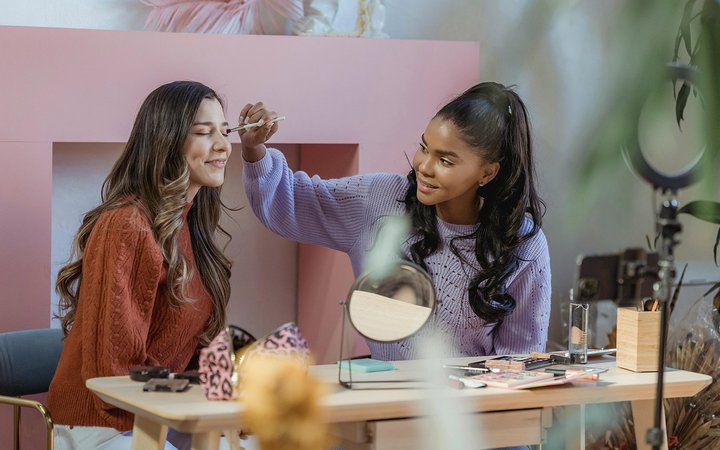Beyond Product Listings: Showcase Your Products Online

Creating great product listings in your Shopify store—with high-quality photos and a well-written product description—is a good start, but it’s far from the end.
That’s because customers will only really see these listings when they visit your website. There are many more opportunities to showcase your products and build awareness on the web. No need to limit yourself to the store alone.
In this article, we explore some strategies you can use to showcase your products outside of your online store. In marketing terms, these types of product presentations fall under “brand marketing” (as opposed to “performance marketing,” which is an approach primarily aimed at making more sales).
With these methods, you can present your products in the best light and really focus on the features you consider important. In certain cases, you’ll even have the chance to position your brand as the creator of the best (or even the only) product of its kind.
Affiliate marketing
Affiliate marketing is a popular strategy where businesses provide special links to anyone with good enough reach—meaning influencers, magazines, local news outlets, etc.

Your new affiliates will then feature the affiliate link in their content, so when a customer clicks on it and purchases the product, the content creator receives a small commission.
The content that features the links can vary anywhere from product reviews and endorsements to purchase recommendations, buying lists and gift guides, such as those made popular by NYT’s Wirecutter.
If you are launching a new brand, being featured in a gift guide together with other well-recognized products may help you gain credibility.
The benefit of affiliate marketing is that you only pay the content creator commissions for completed sales, so the costs are very transparent and based purely on actual results. There are over a hundred different affiliate marketing apps on the Shopify app store, so just pick the one that suits you best.
Influencer marketing
Sometimes, just one mention from an influencer—a popular, influential social media personality—may be enough to jumpstart your brand.

Influencers create content for millions of people and use their platforms to recommend or endorse brands and products to their audience for money.
Influencer marketing is a brilliant way to show your brand to a new audience in a way that leaves a deeper mark than a simple banner ad.
Stanley’s incredible rise in popularity is often credited to this viral video of a woman rescuing her cup from a burnt car and finding out there’s still ice inside.
Just be careful about what sort of influencers you choose to work with. When celebrities such as actors or singers mention your brand on Instagram, it may be seen by many, but with no actual effect on sales. On the other hand, if an expert in their field with a fraction of the celebrity’s audience endorses your product to their followers, they may be much more likely to trust them and buy the product from you.
Finally, if you want to work with an influencer that uses comedy, we recommend you give them free rein when deciding what they’ll do with your product. The result comes out funnier when you let them do humor the way their audience is used to.
Forum posts
Another way to steer how your brand is received on the internet is to participate in discussion sites like Reddit, Hacker News, or more specialized forums. These spaces get daily visits from enthusiasts who are more likely to appreciate a niche brand and share their experiences with others.

Create a company account on these sites (just make sure that it doesn’t violate the forum rules) and post about new product releases, promotions, or reply to other users’ posts to help or provide customer support.
Even running an “AMA”—Ask Me Anything—with a company founder or a designer is a great way to build community, create more personal connections, and show how people behind the brand really think.
Reviews and unboxing videos
Creating your own channel—be it YouTube, Instagram or TikTok—is a great way to showcase your products in a context that can help you position your brand and appeal to its target audience.
Some brands purposefully market their products using “aspirational marketing,” meaning they present products as built for professionals by professionals, knowing full well that their target group is actually just consumers or enthusiasts.
For example, when Peak Design started, it positioned itself as a brand aimed at serious photographers, but now moved into a more “enthusiast” audience, along with a shift to general-purpose goods and a much more informal but funnier style of videos.
Start with simple unboxing or setup videos to show how your product looks when it’s “live” and used in a space. What are its features and how do people use it?
Later, you can move into more “lifestyle” content or show the new, unexpected ways customers interact with your products.
Instructional videos
Instructional videos are a whole separate category that allows you to show customers how to use and maintain your products. This type of content can help people feel more comfortable using the things you’re selling.

To start off with, we recommend you pick topics your customers contact you about often and film a series of instructional videos covering them. Just remember the 3 basic rules:
- Include clear, step-by-step instructions in the video
- Use the video description to include a text version of the steps taken from beginning to the end
- Mention the models or SKUs of products the video applies to so people don’t get confused.
Ask yourself how many times you searched how to do something (like, for example, cleaning a coffee machine or replacing wipers on your car) and resorted to watching a video instead of reading the instruction manual?
Remember: If you don’t record the instructional video yourself, someone else will, and you will have no control over the relevance or quality of the video.
Show your products in real-life contexts
If you want your products to be noticed, you’ll have to engage with customers where they spend most of their time: social media sites, community forums, and popular video platforms.
When you work with influencers, make posts on forums, or create your own content, you give people a reason to care about your products in real-life contexts.
The goal isn’t just to sell. It is to connect with your audience on a deeper level and offer them something more than a product: a relatable story, a solution to their problems, or an experience that speaks to them. It’s about showing how your product fits into their life.
Professional invoices for Shopify stores
Let Sufio automatically create and send beautiful invoices for every order in your store.
Install Sufio - Automatic Invoices from the Shopify App Store